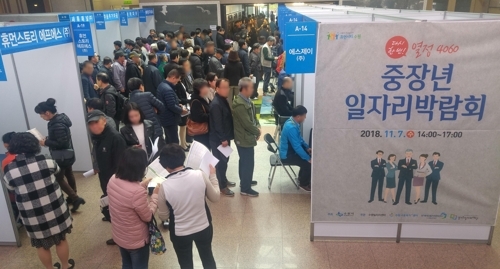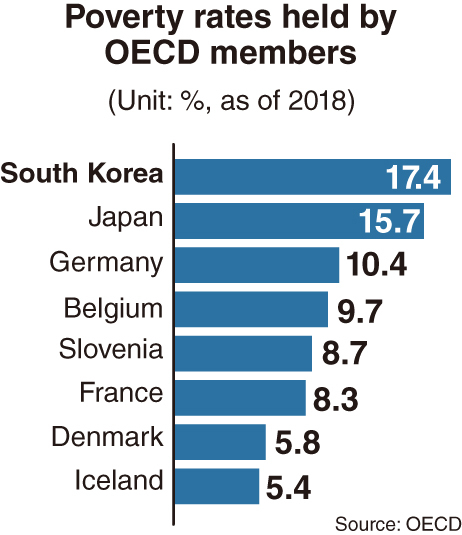[News Focus] Korea sees widening income disparity
Analysts say nation’s middle income bracket has shrunk
By Kim Yon-sePublished : Jan. 7, 2020 - 13:05
SEJONG -- South Korea saw income polarization between the haves and have-nots continue to widen over the past few years.
Some research analysts say the nation’s middle income bracket has collapsed and a large portion of middle-income households should be reclassified as part of the low income bracket.
Comparison data from the Organization for Economic Cooperation and Development for the past decade backs up their arguments.
The OECD compared the poverty rates of 35 of its 36 members as of 2018. (Only New Zealand was excluded.) The poverty rate is the percentage of people whose income is less than half the median household income, according to the organization’s definition.
Some research analysts say the nation’s middle income bracket has collapsed and a large portion of middle-income households should be reclassified as part of the low income bracket.
Comparison data from the Organization for Economic Cooperation and Development for the past decade backs up their arguments.
The OECD compared the poverty rates of 35 of its 36 members as of 2018. (Only New Zealand was excluded.) The poverty rate is the percentage of people whose income is less than half the median household income, according to the organization’s definition.

For example, if a nation’s median household income were 50 million won ($42,700) per annum, the poverty line would be 25 million won.
Korea posted a poverty rate of 17.4 percent, the third-highest among the 35 economies analyzed, as compared with 16.6 percent in Mexico, 16.5 percent in Chile, 15.7 percent in Japan, 14.4 percent in Greece, 10.3 percent in Poland, 9.2 percent in Ireland and 8.5 percent in Slovakia.
Iceland posted the lowest poverty rate of all, 5.4 percent. Next were the Czech Republic with 5.6 percent, Denmark with 5.8 percent, Finland with 6.3 percent, Hungary with 7.8 percent, France with 8.3 percent and the Netherlands with 8.3 percent.
The poverty rates for Turkey (17.2 percent), Lithuania (16.9 percent), Latvia (16.8 percent) and Estonia (15.7 percent) were also lower than Korea’s.
Among English-speaking countries, the UK, Australia and Canada were at similar levels with 11.9 percent, 12.1 percent and 12.1 percent, respectively. But the US posted the second-highest poverty rate, 17.8 percent, among the 35 nations studied.

The poverty rate for seniors, defined by the OECD as people aged 66 or over, was much higher in Korea. In this age group Korea topped the list with 43.8 percent, far surpassing the corresponding figures for the US (23.1 percent), Japan (19.6 percent), Sweden (11.3 percent), Italy (10.3 percent), Spain (9.4 percent) and Belgium (8.2 percent).
Iceland recorded the lowest poverty rate for seniors, 2.8 percent. Next-lowest were Denmark at 3 percent, the Netherlands at 3.1 percent, France at 3.4 percent, Norway at 4.3 percent and Slovakia at 4.3 percent.
The Moon Jae-in administration recently created a huge number of public-sector jobs for seniors. But the elderly poverty rate had climbed further to 47.4 percent as of September 2019, according to Statistics Korea.
Market insiders say the number of regular jobs paying an average of 1 million won per month has decreased while the number of nonregular jobs paying an average of 270,000 won per month has increased. A Sungkyunkwan University professor was quoted by a news outlet as saying “(low-quality) jobs in the public sector have had the effect of increasing the proportion of seniors in need.”
Meanwhile, for young people aged between zero and 17, Korea posted a poverty rate of 14.5 percent -- not far behind the corresponding figures for other developed countries.
Germany’s youth poverty rate stood at 12.3 percent, Australia’s at 12.5 percent, the UK’s at 12.9 percent, Luxembourg’s at 13 percent, Japan’s at 13.9 percent and that of the US at 21.2 percent.
But many of the 35 countries posted youth poverty rates of less than 10 percent. Among them were Estonia at 9.6 percent, Switzerland at 9.5 percent, Sweden at 9.3 percent, the Czech Republic at 8.5 percent, Norway at 8 percent, Slovenia at 7.1 percent, Iceland at 5.8 percent, Denmark at 3.7 percent and Finland at 3.6 percent.
By Kim Yon-se (kys@heraldcorp.com)







![[Graphic News] More Koreans say they plan long-distance trips this year](http://res.heraldm.com/phpwas/restmb_idxmake.php?idx=644&simg=/content/image/2024/04/17/20240417050828_0.gif&u=)
![[KH Explains] Hyundai's full hybrid edge to pay off amid slow transition to pure EVs](http://res.heraldm.com/phpwas/restmb_idxmake.php?idx=644&simg=/content/image/2024/04/18/20240418050645_0.jpg&u=20240419100350)





![[From the Scene] Monks, Buddhists hail return of remains of Buddhas](http://res.heraldm.com/phpwas/restmb_idxmake.php?idx=652&simg=/content/image/2024/04/19/20240419050617_0.jpg&u=20240419175937)

![[KH Explains] Hyundai's full hybrid edge to pay off amid slow transition to pure EVs](http://res.heraldm.com/phpwas/restmb_idxmake.php?idx=652&simg=/content/image/2024/04/18/20240418050645_0.jpg&u=20240419100350)

![[Today’s K-pop] Illit drops debut single remix](http://res.heraldm.com/phpwas/restmb_idxmake.php?idx=642&simg=/content/image/2024/04/19/20240419050612_0.jpg&u=)